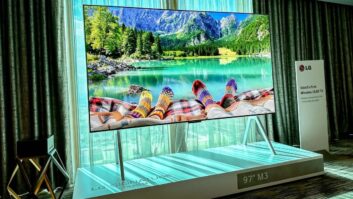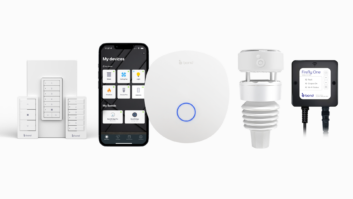Those who think digital color TV receivers are a brand new high-tech phenomenon have another thing coming.
The first all-digital signal processing sets were shown in Europe in the early 1980s. They used a set of five ICs developed by ITT Semiconductor, a European company. A couple of European manufacturers used the chips to make TVs for sale there. The first digital color sets designed for the NTSC standard were offered in Japan by Matsushita and Toshiba, and the first to be made in the United States came from Zenith in 1985.
The digital color TVs of 15 years ago, like their counterparts of today, were very pricey, running double or triple the cost of comparable conventional analog models. Of course in those days no one was even thinking of digital TV broadcasting, let alone digital HDTV. Given that, and the fact that the digital TVs relied totally on conventional analog programming and really didn’t offer much by way of picture enhancement, it was no surprise the ITT-powered sets faded from the market.
The digital TVs we have now provide noticeably better images when displaying standard analog material, and of course, substantially improved pictures when they are fed digitally. So they are selling. Not in any vast quantities, but they are selling.
On the surface, we can safely say that digital color sales are being held back by their relatively high price, as well as the lack of true high-definition programming. Yes, I know, not all digital TVs are HD, but without the promise of adaptability for HD, I doubt many more consumers would spring for the big-bucks digital TV than were willing to buy the ITT models.
But while those two reasons are enough to discourage prospective digital TV buyers, I think there is yet a third factor that will continue to be a weight on the market.
I came to this view while cleaning out a bookcase, where I found a September 1965 issue of TV Guide, tucked away because it had the TV listings for the day my son was born. The magazine listed programming types in parentheses — (comedy), (drama), (movie) and so forth — but there was something else. After some major shows, particularly on NBC, the program listing was followed by a rectangular box that surrounded the word “color.” As I remember, newspaper listings in those days also had a designation for color programming.
Besides letting color TV set owners know which shows were in color, this highlighting of color programming in all the TV listings more importantly served to tell non-color owners what they were missing by having only black-and-white sets in their homes. And as more and more prime-time shows moved to color, the desirability of being a color set owner became more and more apparent.
I recently accepted an invitation to address a local men’s club, and of course what I talked about was the state of the consumer electronics industry. What I learned is that most of the 30-odd attendees had no idea that digital HD broadcasting was available in New York or that digital, let alone HD, TVs were for sale.
And how could you expect them to know? The digital channels aren’t carried on our local cable systems, they don’t show up in the cable-supplied program guides, and they aren’t listed in newspapers. And unless they happen to be in the market for a new set, consumers aren’t likely to search through those colorful inserts our major dealers have stuffed in our Sunday papers to discover that digital TVs are indeed on sale.
While the Consumer Electronics Association is working on many fronts in an effort to get consumers to hear about, understand and even purchase digital TVs, most such efforts are one-shots. Getting local newspapers to include digital TV channel program listings, or even to footnote analog listings to show such programs are being simulcast in digital, would bring the availability of digital programming to the attention of consumers on a daily basis.
Can the CEA do it? With the help of retailers whose advertising feeds big bucks into the newspapers’ cash flow, I think they can. But they will have to come up with a realistically affordable system if the newspapers are to go along.
Meanwhile, the bad press digital TV gets — despite the best efforts of CEA — goes on. The most recent and certainly one of the more harmful potshots at digital TV was taken in the October edition of Time Magazine’s Time Digital supplement.
In an otherwise industry-supportive guide to buying a new color TV, the supplement says: “You’ve probably heard a lot about digital television and HDTV. Our advice is don’t worry about them for now. The rollout of both will be slow, painful and fraught with technical glitches for years to come.”
At least they didn’t say digital TVs were too expensive. I guess we should be grateful for the little things. n
Bob Gerson, TWICE editor-at-large, has covered the CE industry for more than 30 years. He is the founding editor of the publication and its longtime editor-in-chief. In recognition of his work, Gerson was presented with one of the first Consumer Electronics Association Lifetime Achievement Awards at CES this year.













